ISSN ONLINE(2319-8753)PRINT(2347-6710)
ISSN ONLINE(2319-8753)PRINT(2347-6710)
Devendra Singh Bharangar1, Virendra Kumar Yadav2, Saumya Batham3
|
| Related article at Pubmed, Scholar Google |
Visit for more related articles at International Journal of Innovative Research in Science, Engineering and Technology
With the advancement in Internet Technology, human life style is rapidly changing with increasing demand for useful home networking products and their optimal solutions.Availabilty of some crucial factors like consumer electronics, VoIP, multi-user internet gaming, video services etc is major benefit because these factors are contributing at large scale to the increasing need of home networking. In this direction, the establishment of home LANs should be on two distinct Layer 2 technologies, i.e., wired and wireless Ethernet, each of which has variants providing different communication modes and speeds. Apart from high speed internet access, such services will also require a high speed home networking infrastructure that supports QoS. To provide QoS in a network, it is necessary to discover the network topology and available resources. Besides, this paper also discusses and addresses a novel architecture for remote Home Automation Network’s e-Services on an OSGi platform via high speed Internet connections ensuring QoS support. These connections can be ADSL links. Since ADSL is an emerging technology which provides the user of the local loop with broadband speeds, the presence of a signalling mechanism based on RSVP is necessary to maintain the high speed links through the network. Thus, guaranteed bandwidth as well as limited delay advances services can be achieved.
Keywords |
| QBA frame work, ADSL, HAN network, RESV message |
INTRODUCTION |
| The past decade has seen extensive growth of the telecommunications industry, with the increased popularity of the Internet and other data communication services. While offering the world many more services than were previously available, they are limited by the fact that they are being used on technology that was not designed for that purpose. High cost, reliability issues, limited capability, and a lack of standards have imposed major constraints on the market, however, keeping home automation more in the realm of imagination than practice. The advent of wireless technologies, the emergence of home-networking standards, and pull from both the entertainment and the energy markets are now revitalizing efforts to realize that dream, although industry participants are still hotly contesting the implementation methods. |
| A Home Automation Network is a network that consists of home nodes. These nodes are devices, capable of using the communication resources provided by HAN in order to provide services to the user. Many consumer electronic devices in the home are having network capability nowadays, e.g., TV which can access Internet, wireless high definition video streaming, VoIP telephony, etc. On the other hand, bandwidth provided always looks inferior to the increasing demands. Therefore, Quality of Service (QoS) assurance of various home network applications becomes more and more critical to consumer's experience. |
| Home-automation systems use one or more of three media: wire and cable, power line, and wireless. Wire and cable media for home automation include twisted-pair wiring, coaxial cables, and optical fiber. These media have an advantage in their high data capacity and ability to provide a relatively noiseless communications channel for network signaling. Currently, every available home-automation technology falls short in one or more of the areas, although proponents are continuously working to address these shortcomings. Sometimes, the shortfall arises purely from the communications medium. |
| Asynchronous Digital Subscriber Line Technology (ADSL) is a more recent innovation which dramatically increases user bandwidth with potential for speed increase of more than a factor of 50. The major attraction is that it is vimplemented using existing twisted pair telephone lines, theoretically eliminating the need for installation of special cabling. This makes ADSL a more cost effective, and hence commercially viable, system for wide bandwidth data transmission. |
| Asymmetric digital subscriber line (ADSL) is a type of digital subscriber line (DSL) technology, a data communications technology that enables faster data transmission over copper telephone lines than a conventional voice band modem can provide. It does this by utilizing frequencies that are not used by a voice telephone call. It uses existing twisted pair telephone lines to create access paths for high-speed data communications and transmits at speeds up to 8.1 Mbps to a subscriber. This exciting technology is in the process of overcoming the technology limits of the public telephone network by enabling the delivery of high-speed Internet access to the vast majority of subscribers’ homes at a very affordable cost. It is called "asymmetric" because it moves data more quickly from the exchange to you than vice versa. This makes it ideal for applications where you would typically receive more data than you transmit, such as use of the World Wide Web and reception of digital audio/visual material. ADSL is the first generation of Digital Subscriber Line (DSL) technology. |
| A problem that appears is that the high speeds are guaranteed only in the local loop. So, RSVP known as resource reservation protocol, might be used as one solution to this problem. With this protocol the network guarantees the requested bandwidth, delay and network percentage of lost packets for an application. Resource Reservation Protocol has been designed to provide end-to-end quality of service to Internet data flows. Resource Reservation Protocol (RSVP) is an effort to address the performance needs of multimedia applications such as videoconferencing, real-time IP multicasting and Internet telephony. RSVP is a signaling and control protocol that doesn't carry application data. It operates on top of IP in the transport layer of the Open Systems Interconnection (OSI) protocol stack. |
| OSGi: |
| The Open Services Gateway Initiative (OSGi) Specification defines a service-oriented cooperative framework between home and outer home. It uses the OSGi-gateways to deliver products and services to end-users, such as home security control and intelligent home equipments. |
| Internet connections for private users are becoming much cheaper and faster. While the embedded and telecommunication equipments are getting smaller and more powerful, it needs an embedded server that is inserted into the network to connect the external internet to internal clients. |
| The Open Services Gateway Initiative (OSGi) is making developers and enterprises realize the potential of the consumer equipments market such as virtual intelligent home health care etc. But how to provide reliable quality of service management in OSGi-based open middleware is a stringent problem. |
| The central component of the OSGi specification is the service gateway that acts as the platform for many communication-based services. The service gateway can enable, consolidate and manage voice, data, internet and multimedia communications from the home, office and other locations. |
PROBLEM DESCRIPTION |
| Layer 2 technologies used in home networks have different features. For example, in wired Ethernet, the communication mode can be full or half duplex and the communication speed can be 10 or 100 Mbps. In wireless Ethernet, the communication mode is limited to half duplex, but the communication speed may change, even in the same transmission. So, it is more difficult to determine whether QoS can be provided or not in wireless Ethernet as compared to the wired Ethernet. [1] |
| The state of the network changes when the user connects or disconnects, or changes the location of existing ones. It is substantially difficult to determine whether QoS services can be continuously provided or not where the topology of the network changes dynamically and when the network is constituted by a mix of two or more different Layer 2 technologies. When using resource reservation, a predetermined fraction of the network’s resources (i.e. bandwidth) are reserved for the stream. The problem with resource reservation is that stream characteristics are difficult to know in advance. This may cause network under- utilization due to over-allocation of resources. [2] |
| In conclusion, the continuous changes in state of a home network make both the conventional network supervising mechanism and the conventional resource reservation mechanism unsuitable to provide QoS services for real-time communications. |
NETWORK TOPOLOGY AND QOS RESERVATION |
| It is not possible to provide QoS services if the actual bandwidth capacity is less than the bandwidth that application requires. Thus, it is required to know the state of the LAN in order to offer QoS service. It is necessary to grasp the changes in the network state to provide QoS adequately. [1] QoS reservation for communication between AV systems can be done using Intserv. However, RSVP and SBM use polling processes with a period of several dozens of seconds. |
A. Topology Discovery |
| A Layer-2 switch (L2SW) automatically learns the MAC addresses of devices attached directly or indirectly to each one of its ports. The MAC address-port mappings are stored in its Filtering Database (FDB). It is necessary to collect FDB information and to detect the ports to which devices directly attached. |
| 1) Conventional Topology Discovery |
| Conventional topology discovery needs a root node of the network. We regard the router is the root node. |
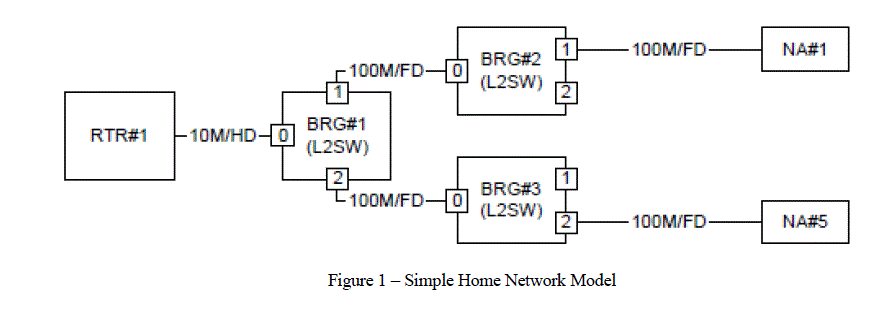 |
| Step1 - The root node sends an Echo Request to all the bridges. After sending the Echo Request, all bridges learn the MAC address of the root and downstream bridges on their respective ports. After receiving an Echo Request, each bridge sends back an Echo Reply. |
| MAC address learning process is shown below. |
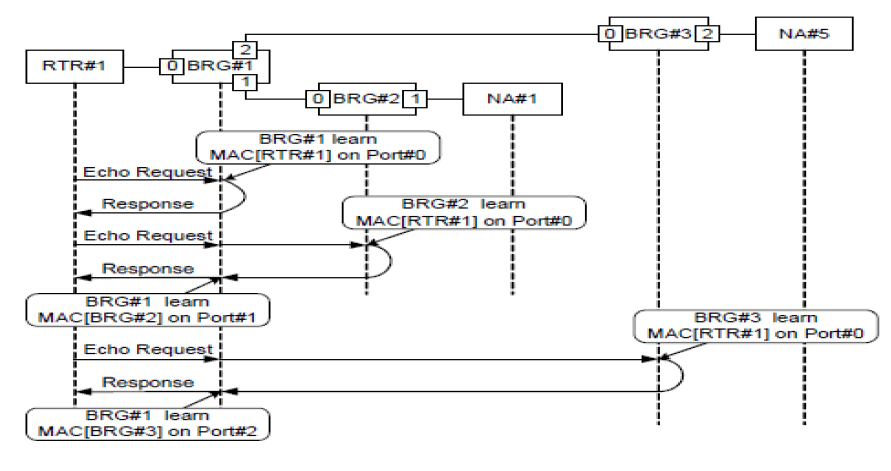 |
| Step 2 – Collect MIBs of all l2Collect MIBs of all L2SWs using SNMP (Simple Network Management Protocol). If a terminal or a bridge has already sent a packet, the bridge that received the packet learns its MAC address. At worst a bridge learned all MAC addresses except itself. |
| Table1 shows that FDB list has entries about the bridges and the root node at worst case. |
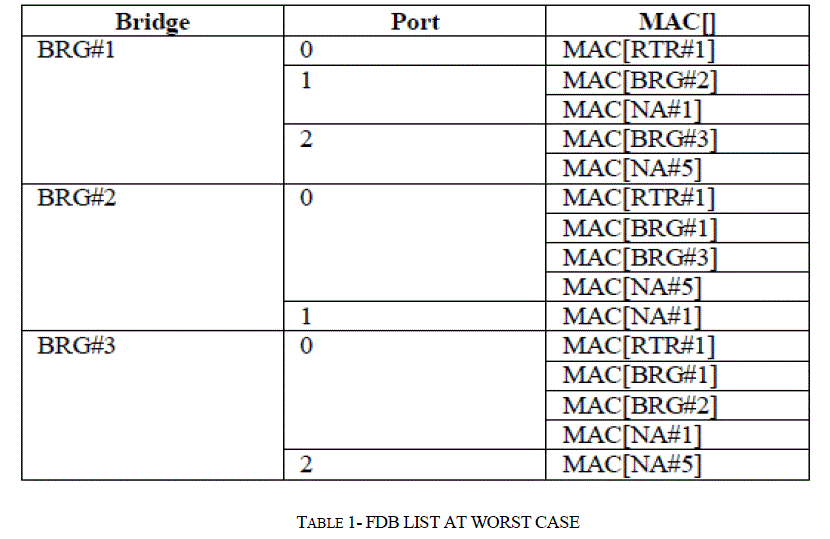 |
| Entries about terminals are once deleted from the FDB list. |
| Table 2 shows that FDB list has entries about the bridges and the root node. |
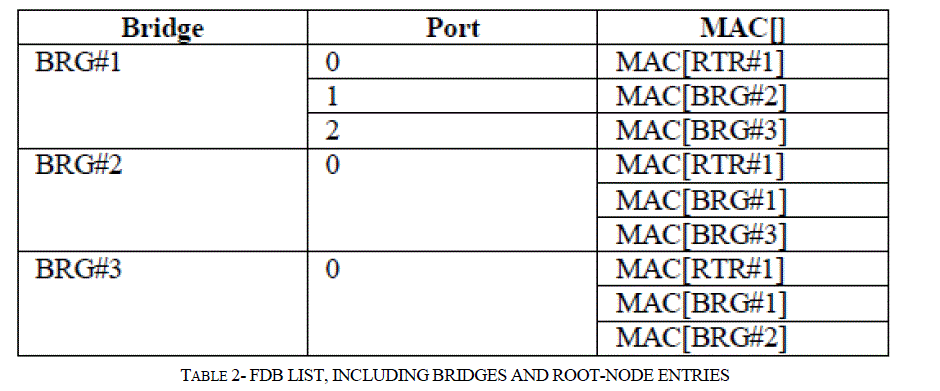 |
| Step 3 – Delete the MAC addresses learned in the port from which the root node Mac address was learned. Grayed entries are deleted. |
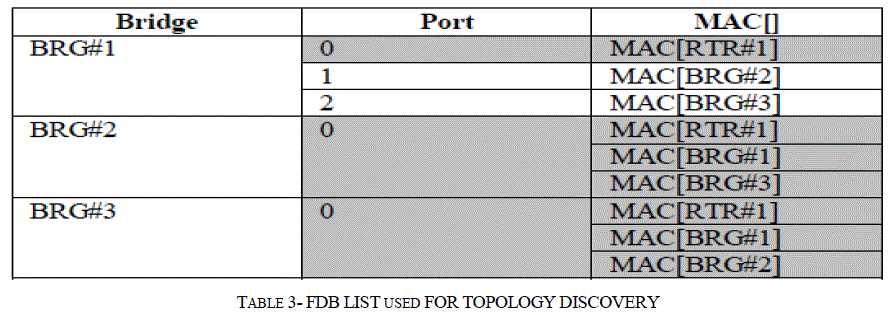 |
| Step 4 – The bridge that learned the MAC address of another bridge determines that it is located between the root node and the other bridge. For example - BRG#1 is located between root node and BRG#2, and also located between the root node and BRG#3. |
| Entries about bridges and entries of the port that is directly attached to other bridge are deleted from the FDB list. Table 4 shows the FDB list including all terminals. Grayed entries are deleted. |
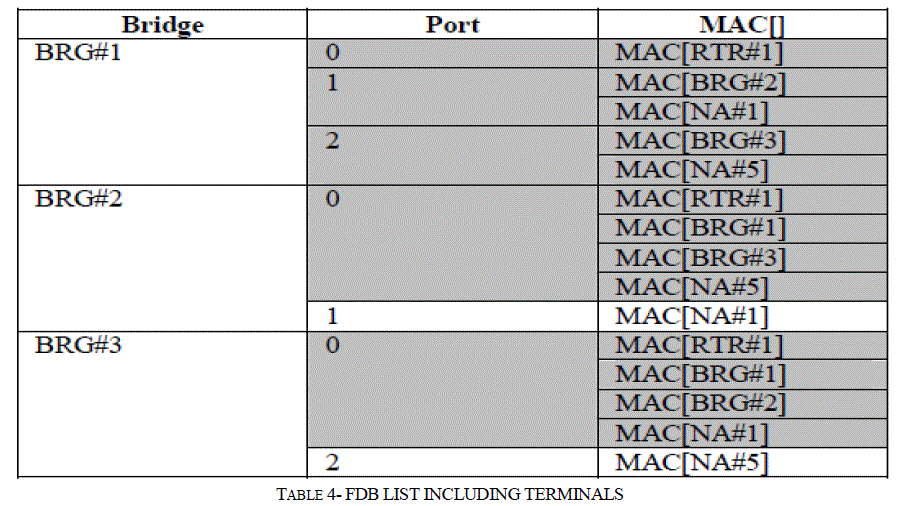 |
| Even if the number of bridges and terminals increases, the topology in the home network can be learned by repeating this process. |
| 2) Conventional Topology Discovery in Home Networks |
| It is not possible to discover topology if a wireless terminal moves from an access point to another one by using conventional topology discovery, as shown in Figure 3. |
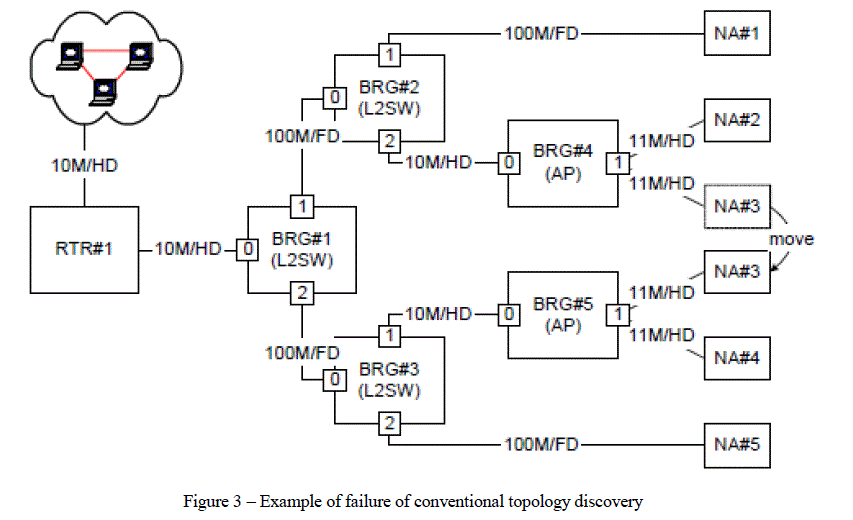 |
| In figure 3, terminal NA#3 moves from Port 1 of BRG#4 to Port 1 of BRG#5. Table 5 shows the corresponding FDB list.[1] |
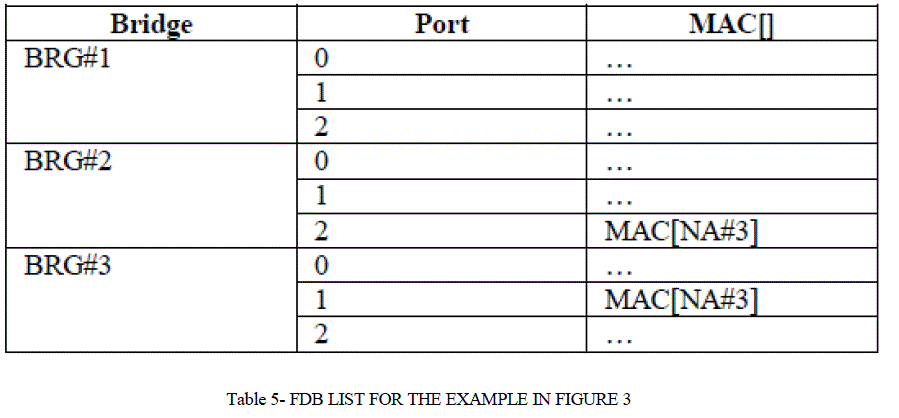 |
| The location of the terminal (NA#3) cannot be determined. Thus, the whole topology of the home network cannot be depicted by the conventional topology discovery. In order to learn the current location of the moved terminal, it is necessary to update all FDBs by requiring the terminal sending a packet out. |
| B. QoS Reservation : |
| The resource reservation process is executed between the sender and the receiver of the communication that requires QoS services. |
| We use the basic idea of the conventional RSVP protocol, which sends the reservation request from the receiver to the sender and returns the reservation response to this request. |
| Figure shows the reservation process: |
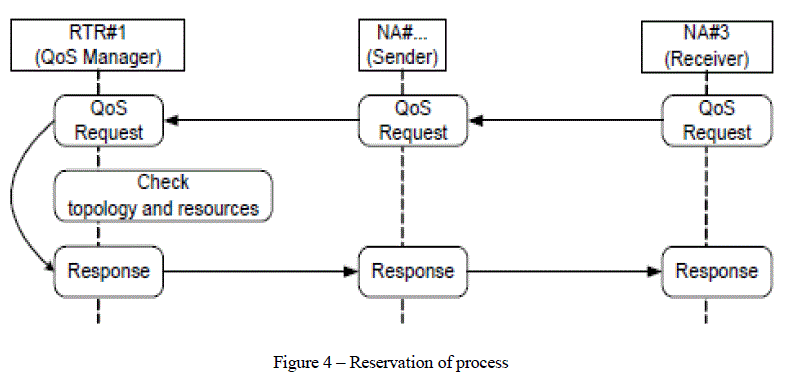 |
| C. Topology Change Detection: |
| To detect changes in the topology such as moving of a terminal or bandwidth changes, a function to supervise the link status is provided to the terminals. |
| The supervising link status function contains the following information i.e., for wired Ethernet, link-up/link-down change, change of communication mode, and change of communication speed. |
| If there are changes in the link status during a communication that uses QoS, the reservation can be reconfirmed immediately using the provided function without waiting for fixed time-out. |
| Figure shows an outline of the reservation reconfirmation process, when the terminal detects a change of its link status. |
| Step 1- The terminal that detected a change in the link status transmits a request to reconfirm reservation to the QoS manager. Also, the request (sent by multicast) notifies all bridges about the change of network topology and updates FDB of all bridges. |
| Step 2- The QoS manager checks whether the terminal has moved. The terminal has not moved from the location at the time of reservation if it satisfies two points: |
| 1. The port to which the terminal directly attached at the time of reservation is still linkup. |
| 2. The MAC address of the terminal is learned on the port. |
| Thus, an “O.K.” response will be sent. If they are not true, then go to step 3. |
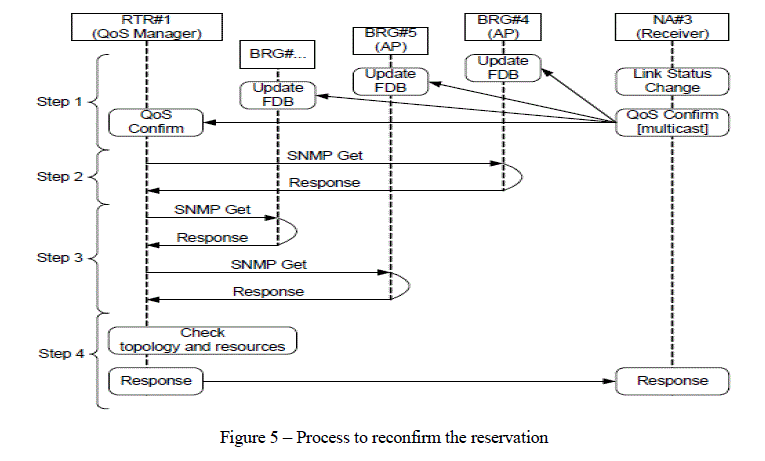 |
| Step 3- The QoS Manager starts to ask the nearest bridge to itself about the port directly/indirectly attached to the terminal, until the bridge whose port is directly attached with the terminal is found. QoS Manager also determine the new path from the sender |
| Step 4- The resources will be reserved if the required resources are available on the new path and then an “O.K.” response will be sent out. In the mean time, the resources reserved on the old path are released. If the resource reservation fails on the new path, a negative response is sent. |
| With the addition of the function to supervise the link status, we can provide QoS even when there are changes in the topology to the receiver. |
TECHNOLOGIES / BACKGROUND |
| 1) HAN Technology : |
| HAN Technology is a provider of security solutions that protect against data loss, system threats and Internet abuse. Our solutions protect local networks and personal computers from Internet threats and offer a secure environment for corporate messaging and communication needs. HAN Technologies is a software development company in India providing Offshore Software Development Services & solutions with services such as outsourcing software development India, Product Development, Web-Enablement Designing, Offshore Application development, PHP Development, Software Development, Multimedia and Design Solutions, ERP. |
| Home automation systems such as telecommunication systems, heating and air-condition systems, lighting systems, security and safety systems, etc. provide an increasing number of functions of growing complexity, while at the same time, open up the possibility to develop entirely new applications. However, the integration of these systems requires that the various home appliances to co-operate automatically without human intervention. Therefore, in order to make HAN a practical reality, the standardization of the involved communications and interworking aspects, is required. There are many ways to classify home networks. The most important distinction is that different technologies are designed for different services: data, entertainment (audio/video), and control. Home data networks, like those in an office environment, provide high-speed connectivity for computers. In new homes, all of these networks are often simply built into-the walls, using twisted pair wiring. In already-built homes, networking technologies either use existing wiring, such as telephone or electrical wires, or they transmit data wirelessly, using an antenna. [4] |
| At the highest level, a residential gateway makes the Networked Home possible by providing a central point of connectivity between in-home devices and a wide area Internet access network. It allows the consumer to access home information from virtually anywhere. There are also several ways for the Internet to connect to homes -- predominantly dial-up modem today, with high-speed broadband options such as ADSL, cable modem, and wireless undergoing aggressive deployments. It is obvious that, the more flexible a HAN is the better e- Services it offers. However, in order to co-ordinate and integrate these e-Services, an efficient HAN network management scheme is required. |
| 2) OSGi Technology : |
| The OSGi alliance is an open forum for Open Service Gateway Initiative. The forum specifies, creates, advances, and promotes an open service platform for the delivering and managing a number of applications and services to all types of networked devices in home, vehicle, mobile and other environments. The OSGi platform enables service providers to download OSGi service bundles from a bundle repository to a gateway. The dynamic installation and uninstallation of bundles make it possible to upgrade software of a device by a remote service provider while the device is operating. [5] |
| The three aspects of the OSGi mission are multiple services, WANs and LANs and devices. Unlike other initiatives, OSGi concentrates on the complete end-to-end solutions architecture from remote service provider to local devices. Because the OSGi specification focuses on providing an open application layer and gateway interface, it complements and enhances virtually all current local networking standards and initiatives. |
| The central component of OSGi specification effort is the services gateway that functions as the platform for many communications based services. The services gateway can enable, consolidate, and manage voice, data, Internet, and multimedia communications to and from the home, office and other locations. The gateway provides a focal point for service providers to deliver services to client devices on the local network(s). The OSGi technical specifications creates an open standard for programmable user premises equipment that includes: downloading of software, application lifecycle management, gateway security, attached device access, resource management. [4] |
| 3) ADSL Technology : |
| Asymmetric digital subscriber line (ADSL) uses existing twisted pair telephone lines to create access paths for highspeed data communications and transmits at speeds up to 8.1 Mbps to a subscriber. This exciting technology is in the process of overcoming the technology limits of the public telephone network by enabling the delivery of high-speed Internet access to the vast majority of subscribers’ homes at a very affordable cost. |
| ADSL uses two pieces of equipment, one on the customer end and one at the Internet service provider, Telephone Company or other provider of ADSL services. At the customer's location there is an ADSL transceiver, which may also provide other services. ADSL service provider has an ADSL Access Multiplexer (DSLAM) to receive customer connections. Essentially a slower ADSL that doesn't require splitting of the line at the user end but manages to split it for the user remotely at the telephone company. |
| ADSL links are emerging technology which provides the user of the local loop with broadband speeds. So, a remote end user who manages a home automation network can use an ADSL connection to assure the real time transmission of images, video, signals, etc. |
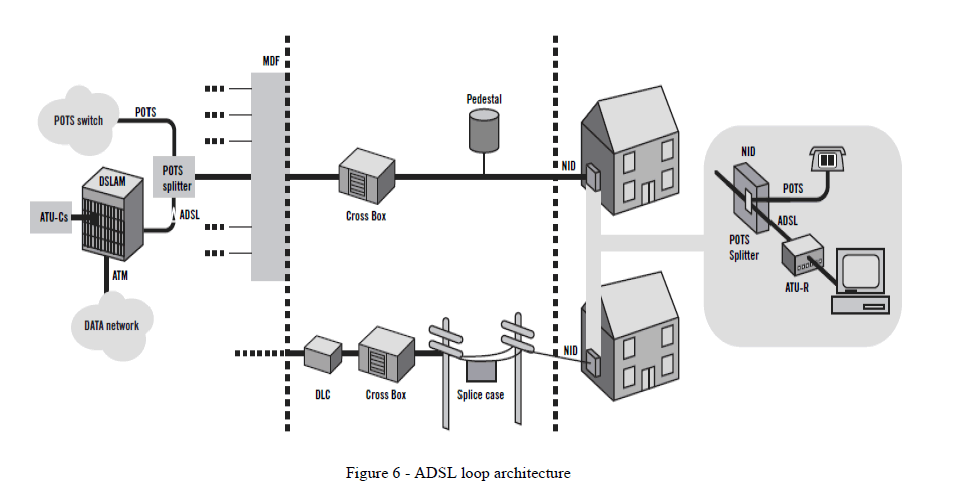 |
| In ADSL, a multiplexing of digital information with a channel of voice is giving the possibility in the customers of maintaining the voice service while simultaneously have access in the digital services of ADSL. This is achieved by frequent multiplexing between upstream channel, downstream channel and voice. [4] |
| The major identified components of the complete end to end OSGi architecture model are: services gateway, service provider, service aggregator, gateway operator, WAN and carrier/ISP, LANs and local devices possibility in the customers of maintaining the voice service while simultaneously have access in the digital services of ADSL. This is achieved by frequency multiplexing between upstream channel, downstream channel and voice. ADSL can be over POTS or ISDN (preferred) and all the data is transferred over the 2-wire twisted pair traditional media. DSLAM collects all the ADSL connections in the local loop, splits the voice from data and forwards the data to the ATM switch. ADSL users use a splitter to separate voice from data and an ADSL modem (or an ADSL router for a LAN, e.g. HAN). ADSL modem provides commonly Ethernet, ATM or USB interface to the end-user to connect his PC (LAN) [4]. |
PROPOSED ARCHITECTURE` |
| 1) General Architecture : |
| This paragraph depicts the outline especially in terms of Internet connectivity and QoS signalling. The HAN is connected to the Internet with a HAN Gateway, as well as the end-user (client). This Gateway can be a PC connected to the ADSL modem through a USB or Ethernet interface. When the remote user wants to establish a connection with the HAN in order to manage the devices within the HAN, RSVP is used for the allocation of resources in all hops in the network. So, the client sends a PATH message, which mainly contains the TSpec, with all the traffic and QoS parameters requested. Every RSVP -enabled router forwards this PATH message to the HAN gateway. The gateway issues a RESV message and every router allocate the requested resources. Two types of services can be obtained (CBR and UBR). Due to the fact that HAN gateway’s upstream is matched to the client’s downstream, ADSL is practically used as symmetrical connection in 1 Mbps maximum. |
| Tspec parameters: |
| p : peak rate of flow (byte/sec) |
| b : bucket depth (bytes) |
| r : token bucket rate (bytes/sec) |
| m : minimum policed unit (bytes) |
| M : maximum datagram size (bytes) |
| Rspec parameters: |
| R : bandwidth (byte/sec) |
| S : slack term (ms) |
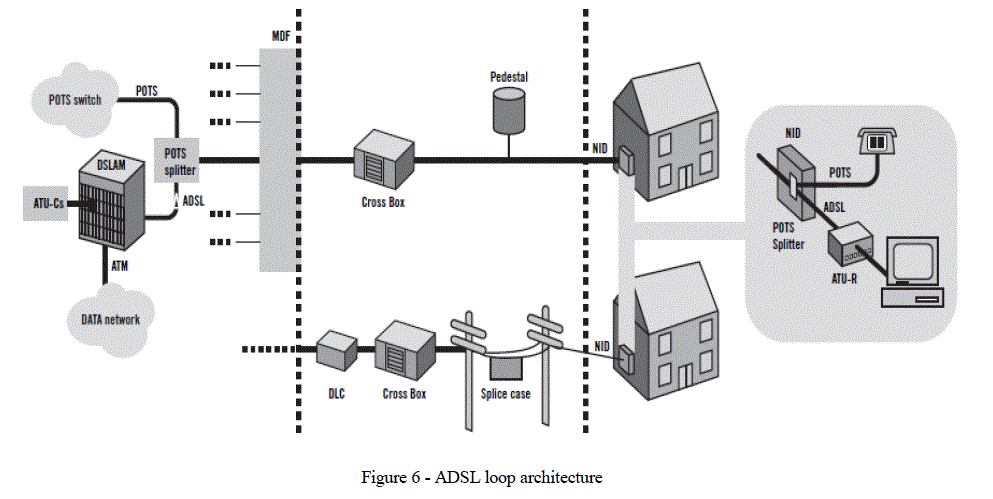 |
| Next step is to distinguish the parameters that determine in the two cases the speed and the QoS of the flow. There are two cases of RSVP mapping, depending on the type of ADSL service requested by the client: Guaranteed for ADSLCBR or Controlled Load for ADSL-UBR service. The mapping mechanism will be presented later. |
| 2) HAN MANAGEMENT |
| Network management is the process of controlling a complex data network so as to maximize its efficiency and proper operation. Depending on the capabilities of the network management system, the management process supports the control and monitoring of the network operation. Until now, implementation of a HAN interface system was performed using an architecture specific for the needs of the protocol upon which the HAN is based. |
| The main objective of the proposed system is the collection of control - monitoring information and management of a HAN, as well as the handling of such information remotely by means of an Internet connection. |
| Management services over TCP and WAP technology are proposed, using a flexible architecture so that a multitude of home networks protocols can be accommodated even simultaneously. The gathered information is diffused to the Internet through a HAN-to-TCP/WAP gateway, which provides the interlinking of the control and the mobile internet network. This gateway has been implemented in software and is hosted in the standard Windows platform. The proposed system and gateway have been integrated in a prototype system based on the EHS network. |
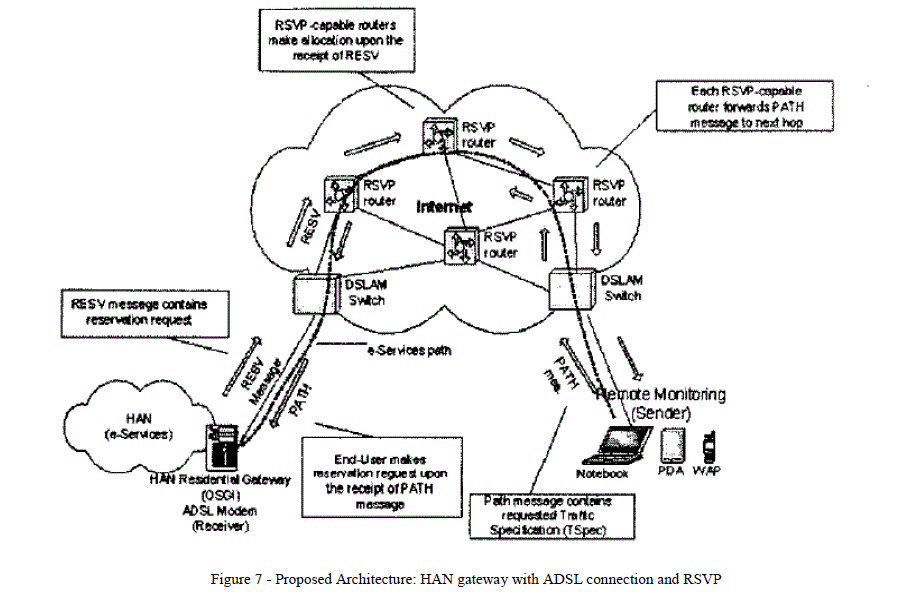 |
| The proposed management system consists of the following elements: the communication protocol, the management service element and the management application services. The protocol’s design consists of new service primitives and the related service parameters as well as a protocol machine based on an object oriented manipulation of the HAN devices. In addition, a management database contains constant information for each HAN device, which is periodically or on demand updated by new information on home variables. |
| 3) ADSL –RSVP Mapping |
| For the combination of ADSL technology with RSVP protocol, a mapping algorithm has been developed. This mechanism maps ADSL parameters in order to pass the client needs (ADSL traffic and QoS parameters) to the network (RSVP capable routers) and the HAN gateway. The following table presents the algorithm for the two types of services: CBR and UBR and also describes the mapping. [4] |
| If ADSL-Client-request = CBR (PCR up, PCR down, CDVT up/down, |
| max CTD, peah-to-peak CDVup/down, clrup/down) |
| Begin (ADSL-parameter mapping to RSVP-parameter) |
| Set RSVP integrated service=Guaranteed |
| r_upstream = PCR upstream |
| p_upstream = r_upstream |
| r_downstream = PCR downstream |
| p_downstream = r_downstream |
| b = r*CDVT/ n |
| |*b = token bucket depth, n = number of rodes*| |
| ADSpec_service class = 1 |
| ADSpec_delay = max CTD |
| M = 48 bytes |
| m = 48 bytes |
| End |
| Else |
| If ADSL-User-request = UBR |
| Then Read ADSL-parameters (PCR up, PCR down) |
| Begin (ADSL-parameter mapping to RSVP-parameter) |
| Set RSVP integrated service = Controlled Load |
| P_upstream = PCR upstream |
| P_downstream = PCR downstream |
| ADSpec_service class = 0 |
| ADSpec_delay = not assigned |
| M = 48 bytes |
| M = 48 bytes |
| End |
| Constract RSVP Message (TSpec, ADSpec) |
| |*Traffic Specification (TSpec) profiles the data flow to be sent*| |
| |*Additional Specification (TSpec) profiles the data flow to be sent*| |
| |*Additional Specification (ADSpec) contains information (service delay bandwidth estimates, etc) generated by the data source on any or all network nodes in the downstream path*| |
| Table 6 – Mapping ADSL to RSVP parameters |
CONCLUSION |
| In this paper, the proposed solution for QoS-based bandwidth allocation for networks (QBA) is the best option to provide principal support for multiple traffic with various QoS requirements in networks. The operational mode of QBA framework is considered with an aim to maximize the potential capacity of the whole system with efficient use of its available resources. This scheme in comparison to the previously existing schemes, demonstrates its unique effectiveness and strength of proposed QBA framework in delivering better QoS and being found suitable for all categories of services in a network. In addition to the proposed solution, some heuristic approach will be considered in future. |
ACKNOWLEDGMENT |
| `This work is supported by ABES Engineering College, Ghaziabad (Uttar Pradesh). We would also like to thanks our Prof. Radhakrisnan, Prof. A. K. Sinha, Prof. Amitavo Sen, Prof G. B. Mund, Prof. Anuja Kumar Acharya, Prof. Sreekanth Asoodi, Prof. M. N. Das and Prof. Yogesh Kumar Mittal for their valuable suggestions they have made during the discussion hours. |
References |
|